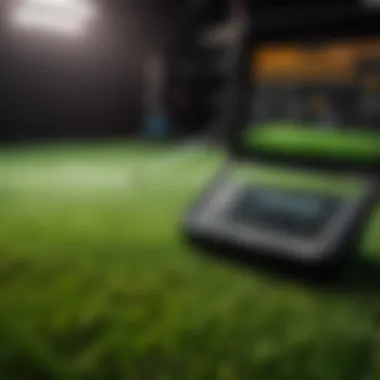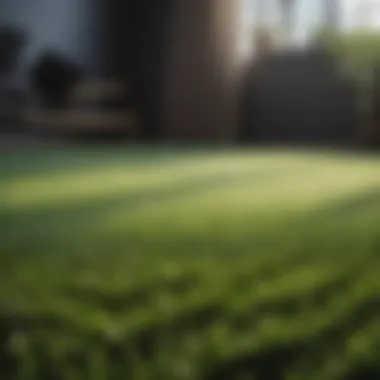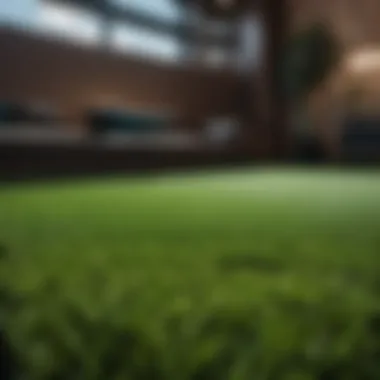Materials:
- Artificial turf rolls: 10 rolls (each measuring 15ft x 25ft)
- Turf adhesive: 5 gallons
- Seam tape: 300ft
- Edging materials: 100ft of flexible edging
- Sand infill: 4 bags (50lbs each)
DIY Steps:
- Measure the area: Using a tape measure, accurately measure the area where you plan to install the artificial turf.
- Clear the area: Remove any existing grass, weeds, rocks, or debris from the area to create a clean surface.
- Prepare the base: Compact the soil and ensure proper drainage by adding a layer of crushed rock or decomposed granite.
- Lay the turf rolls: Unroll the artificial turf rolls in the desired direction, ensuring they fit snugly against each other.
- Seam the turf: Apply seam tape and adhesive to join the turf rolls seamlessly.
- Secure the edges: Secure the edges of the turf with flexible edging to prevent any movement.
- Spread the infill: Evenly distribute the sand infill across the turf to weigh it down and provide stability.
Technical Aspects:
- Tools required: Tape measure, utility knife, seaming tools, roller, gloves
- Timing specifics: Allow for 2-3 days for the installation process, depending on the area size.
- Critical techniques: Proper seam joining, precise cutting, thorough compacting for a smooth finish.
DIY Project Process:


- Installing artificial turf requires precision and attention to detail to ensure a seamless outcome. Start by correctly measuring and preparing the area before laying the turf rolls.
- Seam the turf carefully to avoid visible joints, and secure the edges firmly to prevent any shifting over time.
- Spread the infill meticulously, ensuring even coverage for a professional look and feel.
Troubleshooting Tips:


- If you notice wrinkles in the turf, gently stretch and readjust the rolls for a smooth surface.
- In case of uneven seams, carefully cut and rejoin the turf using seam tape and adhesive for a seamless finish.
Introduction


In the realm of landscaping and home improvement, artificial turf has gained significant popularity for its durability, low maintenance, and aesthetic appeal. However, before diving into an artificial turf installation project, it is crucial to understand the precise measurements and calculations involved. This comprehensive guide delves into the world of artificial turf calculators, offering a detailed exploration of how these tools can help homeowners, landscapers, and professionals accurately estimate artificial turf quantities. By breaking down the key components and factors involved in artificial turf calculation, readers will gain a deeper understanding of the process and its importance in planning and executing turf installations.
What is an Artificial Turf Calculator?
An artificial turf calculator is a specialized tool designed to assist individuals in determining the quantity of artificial turf needed for a specific project. These calculators take into account various factors such as area dimensions, pile direction, and waste allowance to provide precise estimations. By inputting relevant project details, users can obtain accurate calculations tailored to their unique requirements. Artificial turf calculators streamline the planning process, saving time and resources while ensuring optimal outcomes.
Importance of Accurate Turf Calculation
Accurate turf calculation is crucial for several reasons. Firstly, precise measurements help in determining the exact amount of turf required, preventing overestimation or underestimation of materials. This, in turn, leads to cost savings and minimizes wastage. Secondly, accurate calculations contribute to the overall quality and aesthetics of the finished turf installation. Improper measurements can result in mismatched patterns or insufficient coverage, detracting from the visual appeal of the turf. Additionally, precise calculations are essential for efficient project planning and execution, ensuring smooth progress and timely completion.
Overview of Artificial Turf Installation Process
The artificial turf installation process involves several key stages, starting from site preparation to final inspection. Initially, the area designated for turf installation is cleared of debris, leveled, and compacted to create a smooth surface. Subsequently, the artificial turf rolls are laid out, taking into consideration pile direction and pattern matching for a uniform appearance. Adhesive or seaming tape is used to securely join the turf segments, creating seamless transitions. Finally, the turf is infilled with sand or rubber granules to enhance stability and resilience. Understanding the installation process is pivotal for successful turf implementation, ensuring long-lasting results and customer satisfaction.
Key Factors in Artificial Turf Calculation
In the realm of artificial turf installation, understanding the key factors in turf calculation is paramount to achieving a successful and efficient project outcome. Accurate calculation plays a significant role in determining the right amount of turf needed for a specific area, minimizing wastage, and ensuring a seamless installation process. The key factors in artificial turf calculation encompass various elements including area measurement, waste allowance, and consideration for pile direction and pattern matching. These aspects collectively contribute to the precision and effectiveness of turf installations.
Area Measurement
Understanding Square Footage
When it comes to artificial turf calculation, the concept of square footage holds great importance. Understanding square footage entails grasping the total area that needs to be covered by turf accurately. By calculating the square footage of the intended turf installation area, individuals can obtain precise measurements necessary for ordering the correct amount of turf material. This detailed measurement approach aids in avoiding excess material purchase or shortage issues, guaranteeing a cost-effective and efficient installation process.
Converting Measurements
Another vital aspect of area measurement in turf calculation is converting measurements into standardized units. Converting measurements facilitates uniformity and consistency in calculating the required turf quantity. By converting measurements to a common unit such as square feet or meters, individuals can streamline the calculation process and eliminate potential errors that may arise from using varying measurement systems. This conversion method enhances accuracy and simplifies the overall turf quantity estimation process, ensuring optimal resource utilization.
Waste Allowance
Calculating Waste Percentage
In artificial turf projects, accounting for waste allowance is crucial in ensuring adequate material coverage and minimizing material wastage. Calculating the waste percentage involves factoring in potential material losses due to trimming, shaping, and fitting turf pieces during installation. By estimating the waste percentage accurately, project stakeholders can avoid shortages and allocate sufficient material for unforeseen adjustments. This meticulous approach to waste calculation enhances project efficiency and material usage optimization, ultimately leading to a seamless and cost-effective turf installation.
Pile Direction and Pattern Matching
In artificial turf installation, considering pile direction and pattern matching contributes to the aesthetic and functional aspects of the final turf arrangement. Pile direction refers to the orientation in which the artificial turf fibers are installed, affecting the visual appeal and performance of the turf surface. Pattern matching involves aligning and arranging turf pieces to create a cohesive and uniform appearance. By meticulously analyzing pile direction and pattern matching, individuals can create visually pleasing turf layouts that enhance the overall landscape design. Attention to detail in pile direction and pattern matching enhances the overall visual impact and functionality of artificial turf installations, elevating the aesthetic value of outdoor spaces.
Using an Artificial Turf Calculator
Artificial turf calculators play a pivotal role in ensuring precise estimation of turf quantities for any project. In this section, we delve into the significance of incorporating these advanced tools into your turf planning process. Utilizing an artificial turf calculator streamlines the entire calculation process, enabling homeowners, landscapers, and professionals to accurately determine the exact amount of artificial turf required for their specific projects. By choosing the right calculator tool, users can save time, reduce wastage, and optimize the overall efficiency of their turf installation endeavors. Streamlining the calculation process not only enhances accuracy but also eliminates the guesswork often associated with traditional estimation methods.
Choosing the Right Calculator Tool
Selecting the suitable artificial turf calculator tool is a crucial decision that can significantly impact the success of your turf installation project. The key to efficient turf calculation lies in choosing a calculator tool that aligns with the specific requirements and dimensions of your project. Factors such as ease of use, compatibility with different measurement units, and customization options should be considered when selecting the right calculator tool. By opting for a calculator that offers comprehensive features and user-friendly interface, individuals can simplify the calculation process and generate precise estimates with ease.
Inputting Project Specifics
Area Dimensions
When inputting project specifics into an artificial turf calculator, providing accurate area dimensions is essential for obtaining precise calculations. Understanding the square footage of the project area and converting measurements accurately are critical steps in ensuring the calculator generates accurate turf quantity estimates. By meticulously inputting the dimensions of the project area, users can avoid underestimating or overestimating the amount of artificial turf required, leading to cost savings and efficient resource utilization.
Waste Percentage
Incorporating the waste percentage into the calculator input is crucial for predicting and accounting for material wastage during the turf installation process. By calculating and factoring in the waste percentage, users can adjust their turf quantity estimates to accommodate potential wastage, ensuring that they order a sufficient amount of materials for the project. By understanding the impact of waste percentage on overall material requirements, individuals can minimize unnecessary costs and optimize the efficiency of their turf installation projects.
Interpreting Calculator Results
After inputting project specifics and running the calculations, interpreting the artificial turf calculator results is key to making informed decisions regarding material procurement and project planning. Analyzing the calculator results allows users to understand the recommended quantity of artificial turf, enabling them to plan their purchases and installations effectively. By interpreting the calculator results accurately, individuals can adjust their project timelines, budgets, and resource allocations to align with the calculated turf quantities, ensuring seamless and successful turf installations.
Common Challenges and Tips
Common Challenges in artificial turf installation can significantly impact the outcome of the project. One of the common challenges faced by homeowners and professionals is dealing with irregular shapes when installing artificial turf. Ensuring precise measurements and calculations for irregular areas is crucial to avoid wastage and discrepancies in material estimation. Tips for addressing these challenges include breaking down complex areas into simpler shapes for easier calculations and optimization.
Dealing with Irregular Shapes
Irregularly shaped spaces pose a challenge when installing artificial turf due to the intricate measurements required. Breaking Down Complex Areas within irregular shapes involves segmenting the space into smaller, manageable sections for accurate measurement and calculation. This method simplifies the overall process, allowing for precise turf quantity estimation and efficient installation. The key characteristic of breaking down complex areas lies in its ability to streamline the calculation process for challenging spaces, making it a popular choice for addressing irregular shapes in artificial turf installations. This approach offers a unique feature that enables homeowners and professionals to tackle complex areas methodically, minimizing errors and ensuring optimal turf coverage.
Optimizing for Efficiency
Efficiency plays a vital role in successful artificial turf installation, and minimizing wastage is a key aspect in optimizing the process for maximum effectiveness. Implementing strategies to minimize wastage not only saves time and resources but also promotes sustainable practices within the project. Minimizing wastage directly impacts the overall cost efficiency of the installation and enhances the environmental sustainability of the project.
Minimizing Wastage
Minimizing wastage involves meticulous planning and precise execution to minimize excess materials and ensure optimal utilization. By carefully calculating the required turf quantities and considering potential wastage factors, professionals can minimize unnecessary overages and reduce the impact on the environment. This approach not only conserves resources but also contributes to cost savings for homeowners and landscapers, making it a beneficial choice for artificial turf installations. The unique feature of minimizing wastage lies in its ability to promote responsible resource management while maintaining efficient project timelines and budgets.
Adjusting for Pile Direction Variations
Pile direction variations in artificial turf can present challenges during installation, affecting the overall appearance and longevity of the turf. Adjusting for pile direction variations involves careful planning and consideration to ensure uniformity and consistency in turf layout. Understanding how pile direction impacts the aesthetics and performance of the turf is essential for achieving desired results. By adjusting for these variations, homeowners and professionals can create visually appealing and durable turf surfaces that enhance outdoor spaces.
Conclusion
Emphasizing the importance of this technology, the Conclusion underlines how artificial turf calculators empower users to make informed decisions, optimize their resources, and achieve seamless artificial turf installations. By extrapolating detailed insights from each section, readers can appreciate how these calculators eliminate guesswork and ambiguity, transforming what was once a complex endeavor into a straightforward and efficient task. The sophistication of these devices ensures that even irregular shapes or varying pile directions are effortlessly factored into the calculation process, granting users peace of mind and assurance in the outcome of their projects.
Ultimately, this guide serves as a testament to the evolving landscape of landscaping technology, highlighting how artificial turf calculators represent a significant leap forward in improving accuracy, efficiency, and overall project success. Whether embarking on a DIY lawn makeover or undertaking a professional turf installation, the insights gleaned from this guide will undoubtedly equip readers with the knowledge and confidence needed to navigate the world of artificial turf calculators successfully. By embracing these innovative tools, individuals can embark on their turf installation journeys with newfound precision and clarity, setting the stage for beautiful, sustainable outdoor spaces that stand the test of time.





